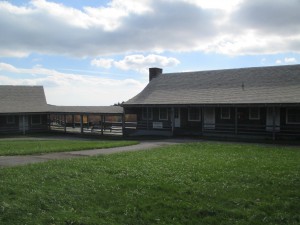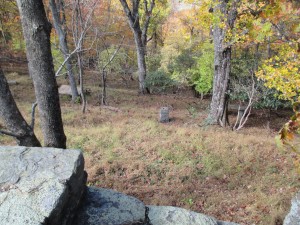Wave of Objections: Renamed in 1953 after North Carolina’s U.S. Representative Robert L. Doughton (D), in many ways Doughton Park exemplifies the ever-present challenge of balancing visitor expectations, experiences, and claims on public land with the National Park Service’s mandate to manage and interpret the natural and cultural resources of the parkway. Renaming Bluffs Park to Doughton Park was the end result of a fierce debate over a proposal to rename the parkway after the congressman the year before.

Doughton Park Memorial Marker in 2014. Hughes, Geoffrey. Doughton Marker. Photograph, October 18, 2014.
In February, 1952, the Raleigh News and Observer ran a story with the headline: “Changing of Parkway Name Brings Wave of Objections.” [1] The proposal to change the name of the Blue Ridge Parkway to the Robert L. Doughton Parkway was suggested by North Carolina’s Governor Scott while on a visit to Washington D.C. [2] While the kind-hearted gesture was meant to honor the retiring congressman for his tireless service, no one, including the Governor or the 88-year-old Doughton was prepared for the political controversy that ensued. In retrospect, perhaps it is not surprising that Virginia legislators were so incensed that they passed a resolution condemning the name change, after all, the parkway passes through both states.
That a seemingly innocent proposal could turn into such a political firestorm is not hard to believe, politics is an appropriate place for controversy and debate. What is more difficult to understand, however, is why political leaders and the chambers of commerce from Virginia and North Carolina objected to the proposal; after all, Doughton was one of North Carolina’s own. Ironically, Doughton’s colleague, Senator Byrd of Virginia, stated the following about the whole affair: “[I have] reason to believe that my friend, Mr. Doughton…does not desire the Blue Ridge Parkway changed to the Doughton Parkway.” [3]
It was the controversy surrounding a proposed name change to the parkway itself that made the renaming of Bluff Park possible. And it made sense for at least a couple of reasons. For one, Doughton consistently advocated for the parkway from its inception until he retired in 1953. For another, he was from the area, having been born in Laurel Springs, located in the same county as Bluff Park. Of course, changing Bluff Park to Doughton Park instead of renaming the entire parkway also made for a good compromise. Associating the parkway with a scenic mountain range would likely appeal to visitors from outside the region more than associating it with a local politician. Recreation areas were already designated as places where individuals could stop and interact directly with the parkway’s historical and cultural resources. They were already places centering around the creation of individual, personal experiences. The parkway, on the other hand, was simply too grand to be associated with any one person.
In 1953, Doughton Park was renamed to honor Congressman Robert Lee Doughton, a supporter and advocate of the Blue Ridge Parkway. Originally called Bluff Park, the renaming of this National Park Service site to “Doughton Park” was a very controversial event. While Robert Doughton did not have anything to do with the renaming of the park in his honor, he did receive a lot of negative feedback from the decision. Nonetheless, the park service did go forward with the renaming.
Bluff’s Lodge was one of only a few hotels on the Blue Ridge Parkway. Originally built in the 1940s, the lodge is located at milepost 241.1. When the hotel opened for business, it featured 24 guest rooms and was built in a log-cabin style. The lodge was originally owned by the National Park Service, but transferred to the ownership of a lodging company called Forever Resorts in 2002. In 2011, when the company decided not to renew its contract, the lodge was closed and is no longer open to the public. Prior to its closure, the lodge encountered multiple issues related to maintenance. [4] Despite hopes that the park would reopen the year after its closure, it remains closed and there is no word on whether it will eventually reopen.
The coffee shop at Doughton Park originally opened around the same time as the lodge. People could come inside to enjoy a warm cup of coffee or a snack after a day of hiking and enjoying the sights of the park. Like Bluff’s Lodge, the coffee shop was taken over by Forever Resorts in 2002. The coffee shop suffered the same fate as the lodge, closing in 2011. As of 2014, the coffee shop remains closed to the public.
Doughton Park boasts hiking trails as one of its main attractions. Along with these hiking trails, Brinegar Cabin features as one of the park’s only attractions. Of course, these trails are the perfect way of taking in the silent beauty of the Blue Ridge Mountains that perhaps cannot be seen from the Parkway itself, but they also offer much more. For example, ranger-led nature walks can provide visitors with a more immersive experience that provides information about the area that they may not have had access to otherwise. By taking part in such an experience, rangers are able to help visitors make sense of Doughton Park’s varied landscape with its open meadows, rolling ridges, steep drainages, and breathtaking vistas. Park rangers are also able to explain their stewardship of the land and, by extension, the visitor’s responsibility as well. In this way, even distant visitors could develop a personal investment in the parkway as a result of being invited into the more intimate world of Doughton Park’s natural history.
Martin and Caroline Brinegar, the original owners of Brinegar Cabin. Unknown. Reproduction of Martin and Caroline Brinegar. Photograph, 1910s. Driving Through Time.
Brinegar cabin, built in 1889, was originally the home of Martin and Caroline Brinegar, and remained part of the area once it was taken over by the National Park Service. Its purpose in the park was to provide “a glimpse into the middle class Appalachian farming/family life from 1885-1935.” [5] Brinegar Cabin was restored in 1940s and opened to visitors. Since 1957, the cabin has been used for various interpretive activities including weaving demonstrations and other folk crafts. [6] Unlike the Bluffs Lodge and the coffee shop, Brinegar Cabin remains open to the public.
A Matter of Scale: From Wildcat Rocks overlook, Caudill Cabin appears as a spec within a forest clearing below. While visitors to the overlook can read the cabin’s interpretive sign at the edge of the overlook, the cabin itself remains one of Doughton Park’s more remote locations. It is dwarfed by the view, a small speck within an unfolding vista. The sign acts as a bridge, spanning both distance and time, bringing an intimate and isolated cabin to the forefront of the visitor’s experience.
The overlook also brings people into contact with the majestic, creating a personal, often humbling experience for visitors. In this respect, Wildcat Rocks overlook exceeds Freeman Tilden’s ideal when interpreting natural beauty, “…first, to create the best possible vantage points from which beauty may be seen and comprehended; and second, to do all that discreetly may be done to establish a mood…” [7] Regardless of whether a park interpreter is present or not, the overlook’s design will always help the visitor create their own interpretation of the vista.
However, the overlook is not just about inspiring an awe of nature. Visitors to Wildcat Rocks can also take a break from the scenery. They can quietly talk to each other on the side of the path or look plants in bloom, or even pose for a memorable picture. In addition to the view, visitors are to Wildcat Rocks overlook are immersed in other sensory experiences as well. From its perch above the Basin Creek drainage, a refreshing breeze or gust of wind can sometimes catch visitors unaware. It is a place that can inspire the hidden daredevil in almost anyone.
One of the more polarizing areas of Doughton Park is where many would believe to be the most calming, the Bluffs picnic area . Established in 1939, it boasts two comfort stations and shelter that was completed in 1941 and over time stretched to over a mile of road upon the Blue Ridge Parkway. It is here where visitors take the time to relax and in some areas enjoy all of the picturesque views Doughton Park has to offer.
A picnic table at Doughton Park. Shaw. Picnic Table. Photograph, March 12, 1938. Driving Through Time.
The majority of the spaces within the Bluffs picnic area are secluded however traveling along the main thoroughfare Ridge Road you are able to catch a glimpse of some of the vistas Doughton Park is known for. This blend of intimate forest covered areas in which to enjoy a moment with a significant other or family member and the grand breathtaking vistas is a central theme that we have explored within Doughton Park. A similar yet lesser known area on the parkway that explores this very same relationship is the area called F. Miller place after the man who owned the tiny cabin amongst the rolling plains of the parkway. The aforementioned views are stunning, providing the visitor with a great view of the vast expanse the Blue Ridge Parkway.
An important yet often overlooked aspect of the Bluffs picnic area at Doughton Park is the underlying racism that took place there. It is no secret that the Blue Ridge Parkway was built during a time where racial tension was extreme all over the country. At one point in 1940 Doughton Park had what was known as the “Negro Master Plan” involving the creation of more segregated facilities and the picnic areas was no exception (credit unbuilt parkway). In picnic area #1 was a designated area for blacks apart from the nicer area for whites that consisted of
a few benches and a plain stretch of grass for gathering (add link to site visit photo #4). This stark contrast in a common area meant for all to enjoy speaks to the pitfalls a recreational area can experience in a time of tension.
Launch Doughton Park digital exhibit
[1] Unknown. “Changing of Parkway Name Brings Wave of Objections (page 1 of 2).” Raleigh News and Observer. February 23, 1952. North Carolina Collection, Wilson Library, University of North Carolina at Chapel Hill. [2] Unknown. “Changing of Parkway Name Brings Wave of Objections (page 2 of 2).” Raleigh News and Observer. February 23, 1952. North Carolina Collection, Wilson Library, University of North Carolina at Chapel Hill. [3] Unknown. “Changing of Parkway Name Brings Wave of Objections (page 1 of 2).” Raleigh News and Observer. February 23, 1952. North Carolina Collection, Wilson Library, University of North Carolina at Chapel Hill. [4] Scott, David, and Kay Scott. “Bluffs Lodge Along The Blue Ridge Parkway Shuttered For 2011.” National Parks Traveler. April 7, 2011. Accessed November 14, 2014. http://www.nationalparkstraveler.com/2011/04/bluffs-lodge-along-blue-ridge-parkway-shuttered-20117899. [5] “National Park Service Cultural Landscapes.” National Parks Service. July 3, 2012. Accessed November 18, 2014. http://www.nps.gov/cultural_landscapes/snp/550138.html. [6] Quin, Richard. Blue Ridge Parkway HAER Report No. NC-42. Historic American Engineering Record, National Park Service, U.S. Department of the Interior, 1997; Buxton, Barry M. “Brinegar Cabin Historic Resource Study.” National Park Service, U.S. Department of the Interior, 1988. [7] Tilden, Freeman, and R. Bruce | Craig. Interpreting Our Heritage. 4th ed., expanded and updated. Chapel Hill: University of North Carolina Press, 2007, 120.


